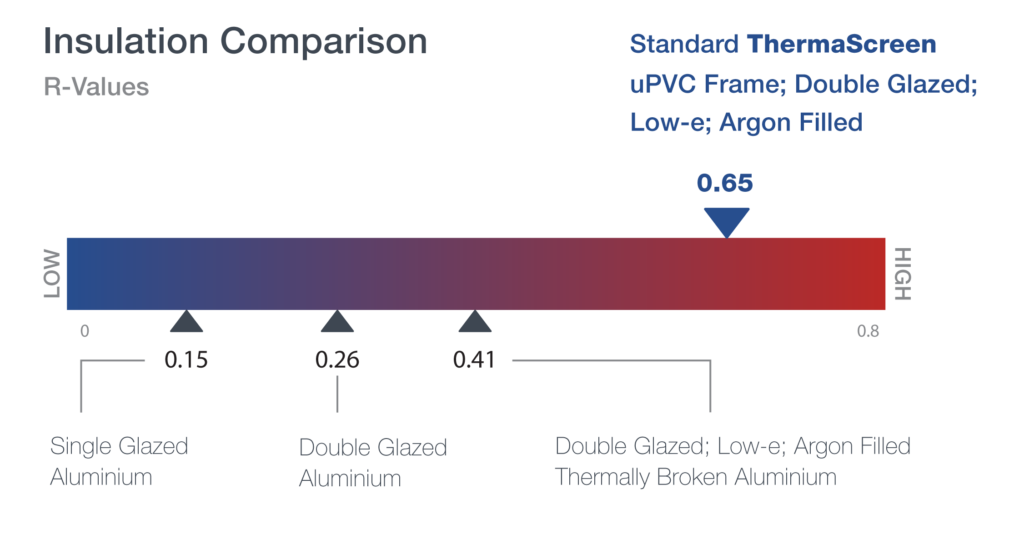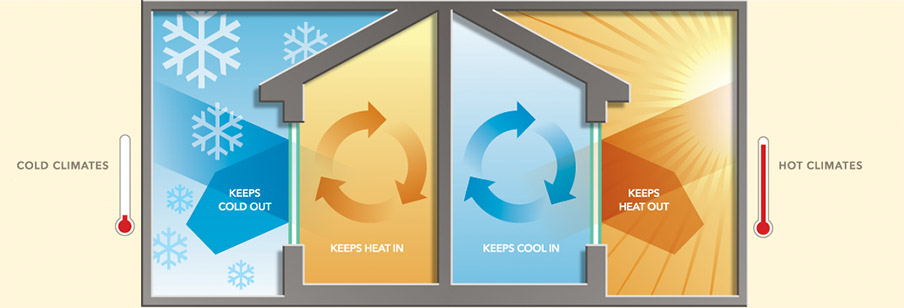This section of the Building A Home In New Zealand centers on the Building Materials topic of windows. It is helpful to read the other Building Material topics including Thermal And Noise Wall Insulation, Solar Heating and Electrical, Attic Venting and Internal Moisture Control, and Heating before Choosing a Builder and Designing a House. The decisions that you make concerning Building Materials can have an influence on these other aspects.
When thinking of new technology aspects of your new home, I am sure that windows crossed very few reader’s minds. You may ask your designer specifically for picturesque windows if they have a great view but give little consideration otherwise. From those we talked to, they don’t know that there are choices for different performance upgrades to standard NZ windows. Most customers often go with opening styles that the designer draws, and use the windows recommended by the builder regardless of the performance. This often means the windows used are the least expensive options which also mean the least performing windows allowed by code. Even in NZ, there are different options and upgrades that you can get to make your windows perform better. This is also an area where things have improved outside of NZ but hasn’t caught on here yet. Minimum performance requirements for windows are much higher outside of NZ than allowed by NZ building code. Imagine windows that don’t have condensation problems, that come with insect screens that aren’t held on by magnets, and have improved glass that not only insulates better, but also prevents carpets and upholstery from being bleached by sunlight over time. We will cover some of those options here.
Thermal And Noise Insulation
One of the largest differences that we noticed between NZ and the US or even Europe is the difference in window technology. In the 1940’s to 1950’s, wood windows everywhere were commonly being replaced with aluminium windows. In many areas outside of NZ, aluminium windows included sliding (slide horizontally) and hung windows (slide vertically). US manufacturers also catered to the needs of the public by incorporating insect screens into the windows. In the 1970’s to 1980’s, thermal inefficiency requirements for windows started forcing the rest of the world away from aluminium. Some people reverted back to wood windows, but more moved to PVC (vinyl) windows. These newer PVC windows often incorporated insect screens but were more energy efficient since PVC is a good thermal insulator where aluminium was a good thermal conductor (aluminium transmits/loses >1000x more heat than PVC). Today, about 80% of all residential windows in the US are PVC with a large portion of the balance being wood. The wood has been improved with an exterior aluminium cladding for improved weather and borer resistance, but PVC is still the predominant choice. If you were to look into Europe, the use of PVC now saturates around 90% of the residential market.
The insulating benefits of PVC windows can be shown with the below graphic comparing R-Values of common windows. An R-value is a measure of the resistance to heat transfer and a higher number is better and denotes better insulation properties. Aluminium window R-values were taken from the MBIE website on R-Values for common materials for awning windows. The PVC values were taken from direct measurements of R-Values for PVC awning windows from ThermaScreen Windows. The standard window sold in NZ is a double glazed standard aluminium awning window with an R-Value of 0.26. The R-Value for the ThermaScreen awning window is 0.65. This is more than double the R-Value of the most common window sold today in NZ. This means that 2.5x more of your paid heating will escape through a standard NZ window when compared to a standard ThermaScreen PVC window. 
This increase in R-Value can have a dramatic impact on your heating bills. In a new house, around 50% of the heat loss is through glazing alone. This is because standard aluminium framed double glazing loses heat at nearly 8 times the rate of a standard insulated wall. Improving the R-Value of the glazing will reduce that heat loss and save on heating costs. BRANZ released a paper in 2014 stating that if New Zealanders who were already getting windows would choose high performance windows like PVC windows instead of the , they would save $730m in heating costs over the first 20 years. That equates to 5,613,000,000 KWh of energy and 600,000 tonnes of CO2 emissions over that 20 years.
Higher performance windows not only limit the transfer of energy, they also help eliminate more noise when compared to standard windows. Visitors are often amazed at how drastic the difference can be between an open and a closed double paned PVC window. Our house is situated about 100 m from a highway, and we don’t hear road noise during the day. During the summer, you can’t hear the cicadas with the windows shut. However, if you live very near a major highway, near trains, or in the flight path of an airport, you may be looking for extra sound insulation. This is where triple paned glass can be worth the upgrade. If possible, make the middle pane a different glass thickness then the outer panes. Different glass thicknesses vibrate at different frequencies and transmit different frequencies of glass. By getting different glass thicknesses, you further cut down on noise transmission.
Opening Style
There are two other differences between the US and NZ windows. The first is that nearly all NZ window openings are awning style windows. These are windows that you are used to with hinges at the top that open outward from the bottom. Since they open outward, there is a risk of running into protruding window corners when the window is open. To prevent this, NZBC D1 Section 1.5.4 states that any building with windows that open out more than 100 mm onto or adjacent to a walkway need to be protected by a physical barrier like a kerb, railing, or projecting sill. Examples are shown below from NZBC D1, Section 1.5.4, Figure 6. It may be the increased liability, or the general disdain for head injuries that has driven the US market to prefer sliding windows.

For many builders, they will either ignore this safety aspect and install an awning window without protection anyway or they will install a fixed window instead. Installing an awning window in this location may cause problems at the inspection stage or will pose health risks for your family later. Everyone that I have asked in NZ has run into an open window or knows someone that has because of the disregard to the NZBC D1 safety precautions. Alternatively, installing a fixed window may not the best option to maintain ventilation and cooling throughout your home. Another easy fix to this is to install a sliding window that slides either vertically or horizontally. These windows don’t open outward and you can have the opening window as well as the improved ventilation.
Insect Screens
The second difference between the US and the NZ market is that every window in NZ comes with an integrated insect screen. These are screens that are part of the window, not held on by magnets, and you don’t have to remove them to open, close, or adjust the window. The reason for the lack of screens on NZ windows isn’t because of the lack of bugs. The business for fly sprays is huge and families tend to not mind exposing their family members and pets routinely to these poisons. Alternatively, consumers are equally happy to have screens installed after the windows. We recently talked with someone that has a 3 BR house that was acting on a $7k quote to have screens put in 3 years after his new NZ windows. On a typical 3BR house, that may be 30% of the original cost of the windows! Still, these aftermarket screens are the magnetic screens that you still have to move out of the way to open or close the window. If you are careful, you can extend the life of these screens, but they will have to be replaced due to the repeated movement.
Low-E glass
Low-E glass is a special coating that is put on glass (typically in between the two panes of glass) that reflects specifically infrared light (heat) and UV light (damaging light) but lets through visible light. During the warmer months, the Low-E coating reflects heat back outside and helps keep the interior cooler. During cooler months, the Low-E coating reflects the heat inside your home back inside your home keeping your house warmer (see below).

The Low-E coating also reflects outside UV light that is responsible for fading your upholstery and carpets over time. The Low-E coatings provide benefits that are often associated with window tinting, but without sacrificing the view or elevating room temperatures. Low-E coatings reflect light where tints absorb the light. Therefore, Low-E coated glass will remain cool in direct sunlight where tinted glass will get hot. This heat can in turn heat the inside of your home like a radiator.
Fire Code
The final thing to consider when designing or choosing your windows is that you may need to use them to escape your home in the case of an emergency. The US has a fire code regulation that at least one window in a bedroom needs to be large enough and accessible so that in the case of a fire that cuts off traditional exits, your family should be able to exit through an open window. This is a safety aspect that hasn’t been regulated yet in NZ, so you may want to consider it during your build. We hope that you never need to use your windows in this manner, but every car comes with a spare tire for a reason.
Next Steps:
This brings to a close the window innovations and options portion of the Building A Home In New Zealand discussion. The next step in the Series addresses Thermal And Noise Wall Insulation.
